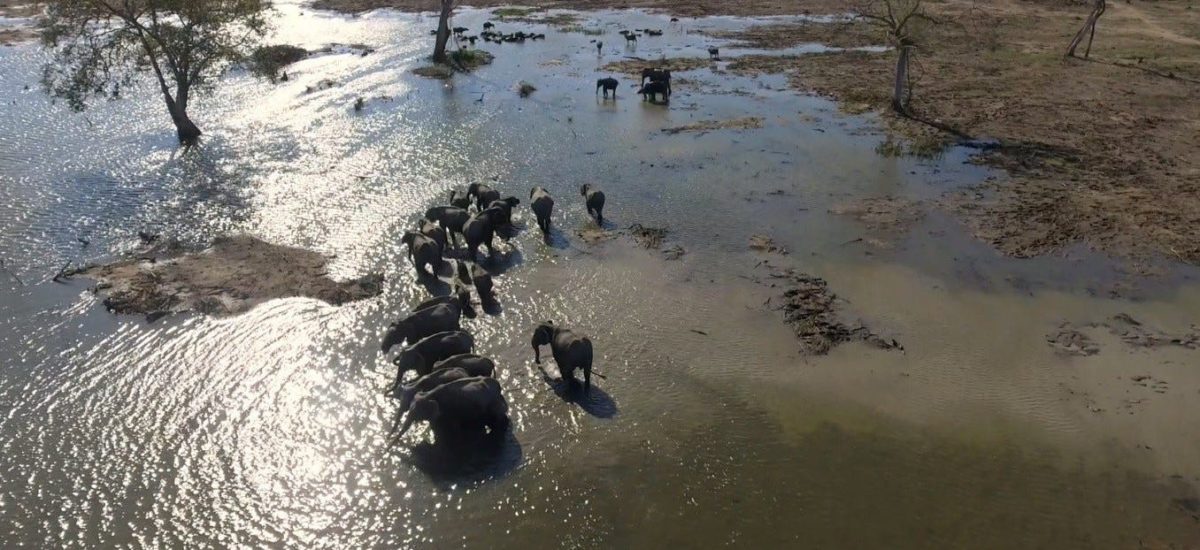Photo courtesy of Sanjana Hattotuwa
For many years the Department of Wildlife Conservation (DWC) has been criticised for its lack of intent in upholding the principles of conservation. There are times, however, when the DWC does act on science and principle, upholds its values and is supported by the relevant political authorities in so doing, and this should be lauded. One such instance is its ban on the use of Unpiloted Aerial Vehicles (UAVs) or drones over national parks and other protected areas under its governance.
The use of drones are not permitted over national parks in both India and the US either. These prohibitions are not only due to the stress that it causes wild animals but also because collisions, especially with bird species, have been fatal. There have been records of drones crashing and causing forest fires.
What does science say?
In a scientific paper published in 2022 in the journal Drones, researchers said, “We investigated how 18 species of megafauna reacted to drone sound pressure levels at different frequencies…The Asian elephant was the most sensitive species to drone noise.”
The study found that leopards, fishing cats, jungle cats and rusty spotted cats were disturbed when drones were flown at low levels. Deer and sambhur were also distressed as were bovines such as water buffalo.
Drones can have a detrimental effect on birds, especially water birds who tend to be in flocks. This became a major issue in 2022 when so-called birdwatchers visiting Mannar went armed with low flying drones, endangering the continued stay and future migration of rare and beautiful species of birds. The Wildlife & Nature Protection Society (WNPS) led the campaign to have this practice stopped and with the cooperation of the relevant departments and ministries, particularly the Civil Aviation Authority, was successful in its endeavour.
A 2015 study on black bears in Minnesota published in the National Geographic showed that their heart rates increased whenever a drone was flown above them. This reaction was worst in mothers with cubs. There have been similar such results from other species from all over the world.
A vital tool for conservation
There are, however, great benefits in the use of drones for science, research and conservation activities such as detecting poaching, illegal felling on monitoring wildlife moving too close to human habitation and illegal encroachment. This, however, has to be controlled and used only for research and conservation purposes as monitored by the DWC.
Yet how can this be justified knowing their effect on wild animals? The study on black bears concludes with the following: “Our results suggest that drone sound pressure levels in different frequencies cause behavioral changes that differ among species, which is relevant to assessing drone disturbances in ex situ environments. The findings presented here can help to reduce drone impact for target species and serve as an experimental study for future drone use guidelines.”
Therefore, except for elephants, who seem to be disturbed at whatever height and noise level a drone is at, the safe elevation and frequency for the other animals needs to be determined and the relevant UAVs used for this purpose.
In an article on the ethical use of drone technology for people and wildlife, Samarpita Chakraborty said, “While drones greatly benefit wildlife conservation, their use also raises ethical concerns. One of the primary dilemmas is the potential disturbance to wildlife caused by drone flights. The presence of drones can induce stress in animals, disrupt their natural behavior, and even lead to the abandonment of nests or young ones. Researchers must balance obtaining valuable data and minimizing interference with the animal’s well-being.”
Should drones be used for non-research and non-conservation purposes?
In recent times, the DWC has been placed under extreme pressure from some in the hotel and leisure industry to permit drones to be flown over national parks for filming wildlife – some who profess to be conservationists themselves. They are supposed to be doing this in collaboration with internationally famed television networks that pride themselves on promoting the cause of conservation. Surely they are aware of the potential harm this can do to Sri Lanka’s wildlife?
Of course, the argument would be that the tourism industry will benefit from this aerial footage in its advertising. Does Sri Lanka honestly wish to attract wildlife tourists to this country by showing film resulting from them being harassed and in fear? Of course, much of that may be deleted from the final production but the deed and its consequences cannot be so easily cut out.
Standing strong for Sri Lanka’s wildlife
Some of the proponents of drones in parks have approached relevant ministries and even the president’s office to have this rule lifted. Fortunately, these institutions have refused and supported the DWC in its intent. This is to be greatly appreciated.
There is a major role in the use of drones in conservation, for research and protection and greater understanding needs to be gleaned on how best to use them. In the meantime, their use should not be misused in the interests of human self-interest at the expense of the welfare of wildlife, particularly by people who advocate conservation but are willing to compromise their principles for personal gain.

